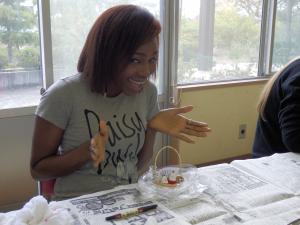As Fukushima prefecture continues to rebuild from the devastating earthquake of March 11, post disaster it has been a ‘all hands on deck’ call to assist in this effort. As significant efforts have been made to repair and rebuild from the physical damage, equal effort needed to be made to repair the prefecture’s damaged image. In connection with the Fukushima prefectural office, several ALTs (assistant language teachers) were invited to participate in a 2 day, of the Aizu area of the prefecture. This tour was orignised in an attempt to shed light to the wider international community on what is currently the situation here and what is being done to return Fukushima to a state of normalcy.
The 2 day Aizu tour started with a tour to the Fukushima Agricultural Technology Centre. Fukushima Prefecture is the 3rd largest prefecture and makes a significant contribution to the agricultural, fishery division of Japan. Post disaster there was a great deal of fear about consuming Fukushima grown products. While at the centre we learned how that radiation levels are farming areas were closely monitored to ensure that food was only accepted from areas with radiation was below safe levels and the process by which food from said locations are tested to ensure food about to be distributed was well below safe levels. For example Japan will only allows food with radiation at a maximum level of 100 becquerels to be distributed for consumption. This is considerably lower than that of Europe which allows up to 1000 becquerels of radiation in produce. Following this tour we were taken to paint our own Okiagarikoboshi, a small doll which is a symbol of good luck and perseverance (no matter how often it’s knocked over it will always get right back up). Also, we toured the famous Aizu castle and we were taken to kitakatta where we tried the very famous kitakatta ramen. Afterwards we were taken to historical store houses around the area and tried the famous types of sake made there. One form of sake was famous for its particular sweet taste because Mozart is played while it’s being made. Finally we participated in a home stay with a Japanese family. Were treated to a great time where we had traditional Aizu dishes for dinner with great company. While there we learned about cotton picking and how to process cotton to be used to make various products. As important as getting to know more about the area and its history of Fukushima, the biggest asset to the prefecture is its people. I strongly believe that the strength of Fukushima rests on the backs of those who live here and work hard to rebuild their home with their ‘never say die’ attitude. I find myself truly inspired by the Fukushima people. They all have a story to tell, it’s impossible to be here and not be affected tragedy of March 11 whether they were directly affected by the incident or affected by the stigma that now comes with living here. I myself have experienced its effect (both innocent curiosity and surprise to blatant rude ignorance) from those within Japan and overseas upon learning where I currently live. Regardless of this fact the people still are very warm and open and welcome you into their homes and hearts. They are open to telling their story not only about what has happened to them to but about how normal their lives truly are in comparison to what outsiders believe their lives to be. I definitely enjoyed my time during the tour and it was something I think more people would benefit from participating in. |  |
| Summary |







